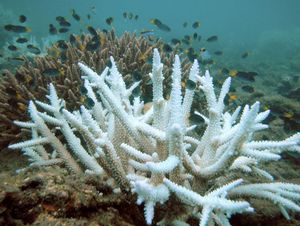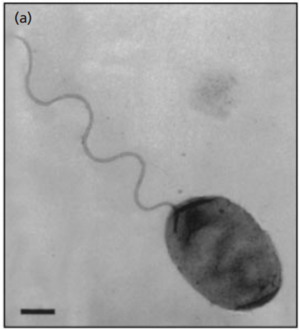Vibrio shiloi
Classification
Bacteria (Kingdom); Proteobacteria (Phylum); Gammaproteobacteria (Class); Vibrionales (Order); Vibrionaceae (Family); Vibrio (Genus). [1]
Vibrio shiloi

Description and Significance
Vibrio shiloi is a known bacterial pathogen to the coral Oculina patagonica found in the Mediterranean sea. [2] O. patagonica and other corals derive their color and nutrient supply from symbiotic relationships with photosynthetic algae called zooxanthellae. [2] V. shiloi induces coral bleaching--or a loss of coral color--and subsequent decline in coral health and eventual death by reducing the amount of viable zooxanthellae available for symbiosis with coral. [2] Coral bleaching affects reefs in other parts of the world and jeopardizes biodiversity sustained within reef ecosystems. Coral gene products functioning to protect the coral from excessive UV radiation exposure have been studied for the potential development of a new sunscreen product [3] Coral reefs also generate significant amounts of tourism dollars annually.
16S ribosomal subunit DNA sequences were sequenced for V. shiloi and compared to other members of the Vibrio genus. [2] The closest match was Vibrio mediterranei which shares 1425 out of 1438 (approximately 99.4%) of the matching base pair sequences for the 16S rDNA coding sequence with V. shiloi. [2] Of the other Vibrio species analyzed, V. shiloi exhibits moderate 16S rDNA sequence similarity to that of Vibrio fischeri [2] V. fischeri also exhibits a symbiotic relationship with a marine animal, the Hawaiian bobtail squid, but has bioluminescent properties functioning in adaptive host organism camouflage [4] as opposed to direct nutrient production seen in V. shiloi. Given the surprising sequence similarity but varying functions between V. shiloi and other Vibrio species, the likelihood of similarities between members of the Proteobacteria Phylum and V.shiloi will vary depending on the species of comparison as this is a varied Phylum.
Structure, Metabolism, and Life Cycle

Vibrio shiloi is a rod shaped, Gram-negative, motile, polarly flagellated bacteria measuring 1.6 x 2.4 micrometers (excluding flagella) when grown experimentally in the absence of coral. [2] When grown in the presence of coral, as would be expected in nature, V. shiloi is not flagellated and individual cells are smaller, approximately 1.0 x 2.0 micrometers. [2] V. shiloi does not have bioluminescence properties, does not produce spores, and when cultured on agar in laboratory has slightly serrated edges and observing swarming consistent with presence of flagella. [2] V. shiloi yields positive catalase and oxidase testing, reduces nitrate to nitite, is a facultative aerobe, and is capable of acidic fermentation. [2] V. shiloi obtains energy from a number of carbohydrate sources including glucose, sucrose, dextrose and glycogen. [2]
V. shiloi is only capable of exerting pathogenic, coral bleaching effects on Oculina patagonica zooxanthellae between the temperatures of 20-32°C [2] but reaches a maximum efficacy around 29-30°C. [5] However, the V. shiloi life cycle is sensitive to the antibiotics penicillin, ampicillin, tetracycline, oxytetracycline, streptomycin and kanamycin as well as 2,4-diamino- 6,7-diisopropylpteridine. [2]
Ecology and Pathogenesis
Vibrio shiloi obtained for the experiment conducted by Kushmaro A., Banin E., Loya Y., Stackebrandt E. and E. Rosenberg was obtained from Oculina patagonica coral samples harvested from the Mediterranean sea of the coast of Isreal. [2]
In their work titled "Virulence mechanisms of the coral bleaching pathogen Vibrio shiloi", Banin E., Ben-Haim Y., Fine M., Israely, T., and E. Rosenberg explain, "Virulence mechanisms of V. shiloi include: (i) chemotaxis to the mucus of O. patagonica, (ii) adhesion to a β-galactoside-containing receptor on the coral surface, (iii) penetration into coral epidermal cells, (iv) differentiation into a viable-but-not-culturable (VBNC) state, (v) intracellular multiplication, and (vi) production of toxins that inhibit photosynthesis, and bleach and lyse zooxanthellae. The toxin that inhibits photo-synthesis is a proline-rich, 12 amino acid peptide." [5] Coral bleaching appears as a lighter shade of the original coral color to completely white depending on the amount of viable zooxanthellae still present in symbiosis with the coral.
References
[1] Taxanomy Browser:Vibrio shilonii [Internet]. Bethesda(MD):National Center for Biotechnology Information; [cited 2013 21 Jul] . Available from: http://www.ncbi.nlm.nih.gov/Taxonomy/Browser/wwwtax.cgi?mode=Info&id=62153&lvl=3&keep=1&srchmode=1&unlock&lin=f
[2] Kushmaro A., Banin E., Loya Y., Stackebrandt E. and E. Rosenberg. 2001. Vibrio shiloi sp. nov., the causative agent of bleaching of the coral Oculina patagonica. International Journal of Systematic and Evolutionary Microbiology [Internet]. [Cited 2013 Jul 21] 51(4):1383-1388. Available from: http://ijsb.sgmjournals.org/content/51/4/1383.full.pdf
[3] Coral studied for sunscreen abilities [Internet]. 2011 Aug 31.[cited 2013 Jul 21] . Available from: http://www.nhs.uk/news/2011/08August/Pages/tropical-coral-sunscreen-properties.aspx
[4] McFall-Ngai M.. Quick Guide: Hawiian bobtail squid. Current Biology [Cited 2013 Jun 21] 18(2):R1044. Available from: http://labs.medmicro.wisc.edu/mcfall_ruby_papers/pdf/2008/McFall-Ngai_2008_CurrBiol.pdf
[5] Banin E., Ben-Haim Y., Fine M., Israely, T., and E. Rosenberg. 2000. Virulence mechanisms of the coral bleaching pathogen Vibrio shiloi. Proceedings 9th International Coral Reef Symposium [Internet]. [Cited 2013 Jul 21] 2:23-27. . Available from: http://www.coremap.or.id/downloads/ICRS9th-Coral_Disease7.pdf
[6] File:Keppelbleaching.jpg [Internet]. 2011 Aug 22. Wikipedia; [2011 Dec 30, cited 2013 Jul 22]. Available from: http://en.wikipedia.org/wiki/File:Keppelbleaching.jpg
Author
Page authored by Jessica Tiffany, student of Mandy Brosnahan, Instructor at the University of Minnesota-Twin Cities, MICB 3301/3303: Biology of Microorganisms.
